Catocala innubens
Catocala innubens
kah-TOCK-uh-lahMin-NEW-bens
Guenee, 1852
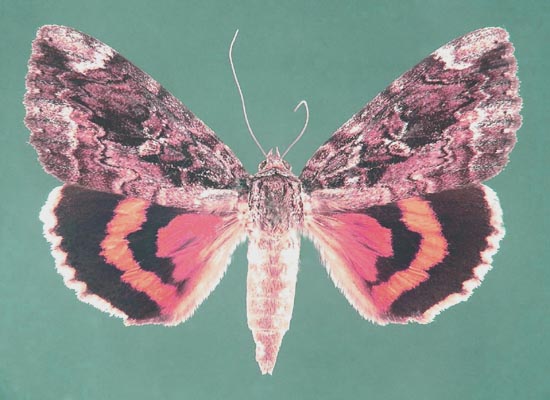
The Betrothed Underwing (female) by Vernon A. Brou.
This site
has been created by Bill Oehlke.
Comments, suggestions and/or additional information are welcomed by Bill.
| TAXONOMY:
Superfamily: Noctuoidea
Family: Noctuidae
Group: Noctuinina
Subfamily: Catocalinae
Genus: Catocala
|
DISTRIBUTION:
Catocala innubens has also been reported in
Alabama,
Arkansas,
Colorado,
Delaware,
District of Columbia,
Georgia,
Illinois,
Indiana,
Iowa,
Kansas,
Kentucky,
Louisiana,
Maryland,
Massachusetts,
Mississippi,
Missouri,
Nebraska,
New Jersey,
New York,
North Carolina,
North Dakota,
Ohio,
Pennsylvania,
Rhode Island,
South Carolina,
South Dakota,
Vermont,
Virginia and
West Virginia.
The forewing is mottled with white, grey and brown, and the subrenifrom spot tends to be lighter in colour, although
it is sometimes obscured by an indistinct blackish bar which runs from the middle of the basal/thorax connection to just below the much lighter apex at
the outer margin. Image courtesy of Dean Morewood.
The hindwing has a lightly barred creamy white to pale orange fringe, and the hind tarsi have four rows of spines.
The following are the same as innubens:
hinda French, 1881
innubenta (Strand, 1914)
flavidalis Grote, 1874
scintillans Grote & Robinson, 1866, form |
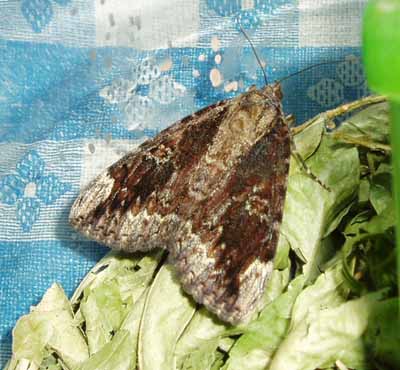
|
The basal area of the hindwing frequently has dark scales/hairs as per the Jim Vargo images below, and the central portion of
the hindwing inner black band outlines a distinct rectangular shape on the body side. The inner side of the outer black band consists of two relatively straight
lines opening at an obtuse angle.
The inner portions of the forewing reniform spot are an orangey brown with a faint outline of white scales. The lower third of the
forewing median area tends to be lighter in colour, revealing a relative proximity between the am and pm lines where they meet the
inner margin, and a pronounced inward pointing "tooth" on the pmline.
The light grey forewing apical patch has only the slightest indication of continuation of subterminal line, making the patch seem quite large.
On lighter specimens, there is a dark extension of the am line toward bottom of the subreniform spot, and then an acute angled
dark continuation of same line back toward body and inner margin.

Catocala innubens, Athol, Worcester County, Massachusetts,
August 29, 2011, courtesy of Dave Small, id by Bill Oehlke.

Catocala innubens, Indiana, 60mm, courtesy of Jim Vargo copyright.
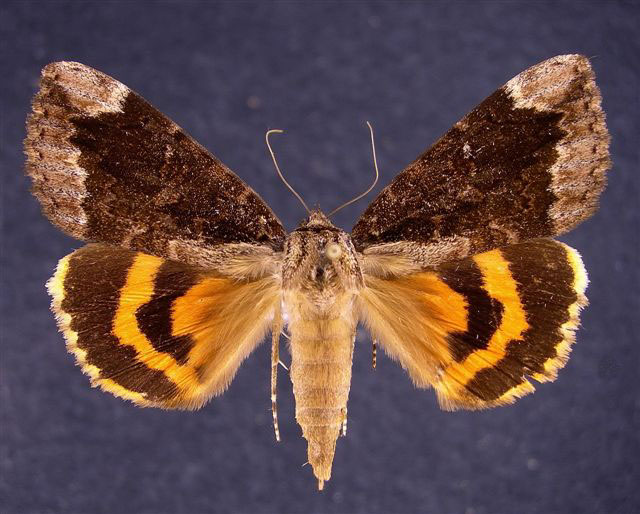
Catocala innubens, Indiana, 60mm, form scintillans, courtesy of Jim Vargo copyright.
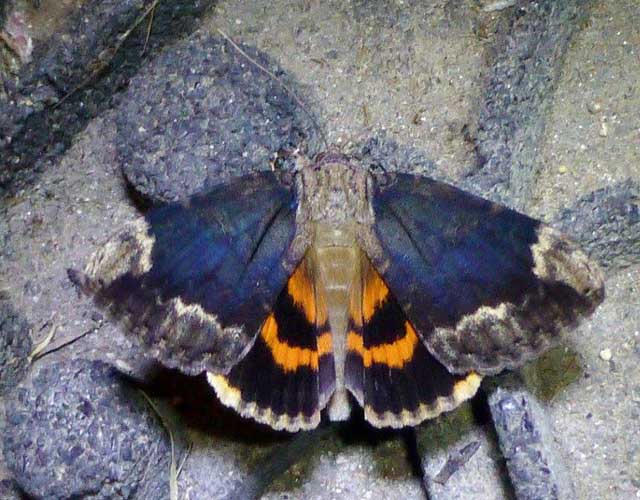
Catocala innubens form scintillans, Athol, Worcester County, Massachusetts,
August 3, 2013, courtesy of Dave Small, id by Bill Oehlke.
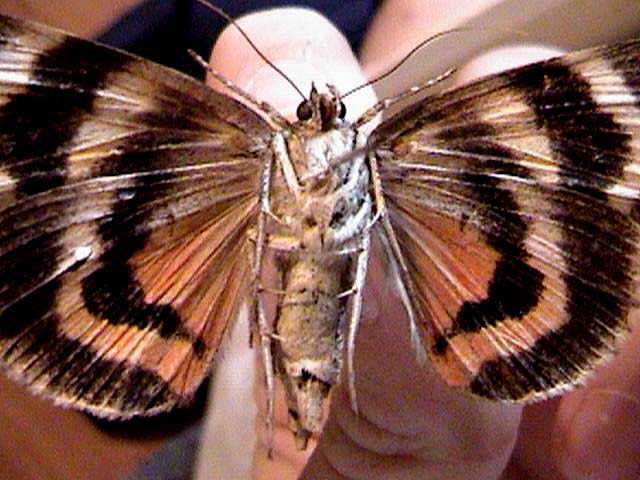
Catocala innubens (verso), Ohio, 66mm, courtesy of Zak Vanloocke.

Catocala innubens, Athol, Worcester County, Massachusetts,
August 29, 2011, courtesy of Dave Small, id by Bill Oehlke.
FLIGHT TIMES AND PREFERRED FOOD PLANTS:
 |
Catocala innubens flies as a single generation with moths on the wing from June through September.
The central Pennsylvania moth, left, courtesy of Dean Morewood, emerged on May 19.
Larva had benefit of greenhouse heat so eclosion is probably advanced slightly.
Adults come in to lights and also respond to baits.
The Catocala innubens caterpillar shows a preference for Gleditsia triacanthos and may be host specific. |
ECLOSION:
Adults eclose from pupae formed under leaf litter.

Catocala innubens (male) form scintillans,
courtesy of Vernon A. Brou, Louisiana.
The form scintillans has forewings that are almost completely brown to the subterminal line and then almost completely light grey to the outer margin.
Visit Catocala innubens, Eddie Jones Park, Caddo Parish, Louisiana, May 30, 2012, Jeff Trahan.
Visit Catocala innubens form scintillans, taken at bait, July 9, 1994, (also forms hinda and regular and verso),
Mason, Ingham County, Michigan, courtesy of Harry King.
Visit Catocala innubens, Worthington, Nobles County, Minnesota, July 10, 2012, Tom Middaugh.
Visit Catocala innubens form scintillans, Windsor, Ontario, July, 2018, Maurice Bottos.
Visit Catocala innubens, Amherst, Hampshire County, Massachusetts, July 20; August 6, 8; 2011, Joshua S. Rose.
Visit Catocala innubens, form scintillans, Athol, Worcester County, Massachusetts, August 3, 2013, Dave Small.
Visit Catocala innubens form scintillans, also typical form, Ozark Mountains, Searcy County, Arkansas,
August 17, July 2, 2011, Marvin Smith
SCENTING AND MATING:
Catocala innubens females emit an airbourne pheromone and males use their antennae to track the scent plume.
EGGS, CATERPILLARS, COCOONS AND PUPAE:
Eggs are deposited on tree bark in the fall and hatch the following spring.
Of the following two larval images, Dean Morewood writes,
"I found them feeding on honeylocust trees (Gleditsia triacanthos) in a greenhouse here in central Pennsylvania. Prior to being moved
into the greenhouse, the trees had been grown in an outdoor nursery here for a couple of years. Not sure where the trees originally
came from, but I'm pretty sure the insects would have originated here."
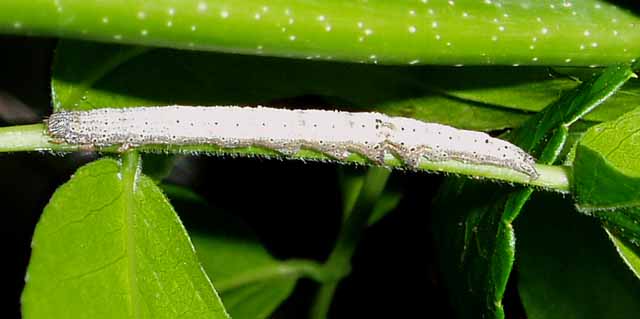
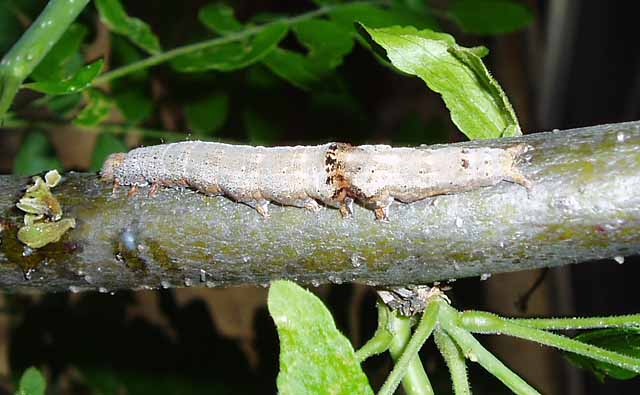
The top larva is probably third or fourth instar, while the bottom larva is mature.
Larval Food Plants
Listed below are primary food plant(s) and alternate food plants. It is hoped that this alphabetical listing followed by the common
name of the foodplant will prove useful. The list is not exhaustive, although some species seem very host specific.
Experimenting with closely related foodplants is worthwhile.
Gleditsia triacanthos.......
|
Honey locust
|
This page is brought to you by Bill Oehlke and the
WLSS. Pages are on space rented from Bizland. If you would like to become a "Patron of the Sphingidae/Catocala Sites",
contact Bill.
Please send sightings/images to Bill. I will do my best to respond to requests for identification help.
Enjoy one of nature's wonderments: Live Saturniidae (Giant Silkmoth) cocoons.

|

To show appreciation for this site, click on the flashing
butterfly to the left, a link
to many worldwide insect sites. |
Return to Canadian Index
Return to Main Catocala Index













